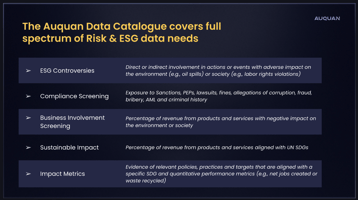Our financial services customers have been using Auquan to identify under-the-radar risks and...

Canada announced the release of a new draft regular to cut emissions in the oil and gas industry by 35% by 2030. The new regulations introduce a new emissions allowance system to cut greenhouse gas emissions pollution and promote sustainability across the country.
Private equity and credit firms, asset managers, and impact investors should pay close attention to this regulation as it has the potential to increase costs in the supply chain, drive innovation in renewable energy technologies, and have business and economic implications beyond the oil and gas industry.
Let’s explore the new regulation proposed by Canada in detail.
The new draft introduced by the Government of Canada is a set of rules and initiatives that are part of the 2030 Emissions Reduction Plan. Along with other standards, the regulation introduces a cap-and-trade system that incentivizes companies to invest in cleaner technologies while allowing for continued production growth.
The proposed regulation aims to cut emissions from the oil and gas sector equivalent to 35% below 2019 levels. It sets a limit on pollution, not production, and it has been made clear by extensive engagement with industry insiders.
The oil and gas GHG pollution cap is expected to help the sector grow rapidly. By reducing carbon emissions, the regulation highlights Canada’s commitment to achieving net-zero emissions by 2050.
The Government of Canada is continuing to consult on the final draft of these regulations, which is expected to be released next year. Concerned professionals can submit written comments on the proposed regulation during the formal consultation period from November 9, 2024, to January 8, 2025.
Financial institutions, private equity and credit firms, asset managers, and impact investors operating in Canada should carefully consider the new draft regulation released by the Government of Canada, in their strategies and risk assessments to capitalize on opportunities and mitigate potential risks.
However, keeping up with government initiatives like this and assessing them accurately can be challenging. This is where Auquan comes into play.
Auquan automates and streamlines deal sourcing, due diligence, monitoring, ESG/sustainability, and compliance workflows so teams can move faster and more efficiently. Using advanced AI, Auquan generates material and sustainability insights on any entity worldwide — public or private — fine-tuned for your team's investment and lending requirements.
Let's explore how Auquan can help you and your team eliminate tedious and time-consuming manual data work and focus more on what you do best.
Each day we spotlight under-the-radar investment themes and idiosyncratic risks pulled from our intelligence engine, often involving emerging markets, supply chain issues, ESG risks, and the impact of regulatory changes.

Our financial services customers have been using Auquan to identify under-the-radar risks and...
.jpg?height=200&name=Image%20Cards%20for%20Blog%20Posts%20and%20Social%20Media%20(24).jpg)
We’re proud to announce that Auquan has won the “Most Innovative ESG Regulatory Reporting Solution”...
.jpg?height=200&name=Image%20Cards%20for%20Blog%20Posts%20and%20Social%20Media%20(5).jpg)
At Auquan, we’re always looking for trailblazers who can push the boundaries of what AI can...
Each day we spotlight under-the-radar investment themes and idiosyncratic risks pulled from our intelligence engine, often involving emerging markets, supply chain issues, ESG risks, and the impact of regulatory changes.

Interested in working at Auquan? Click Here
Canada announced the release of a new draft regular to cut emissions in the oil and gas industry by 35% by 2030. The new regulations introduce a new emissions allowance system to cut greenhouse gas emissions pollution and promote sustainability across the country.
Private equity and credit firms, asset managers, and impact investors should pay close attention to this regulation as it has the potential to increase costs in the supply chain, drive innovation in renewable energy technologies, and have business and economic implications beyond the oil and gas industry.
Let’s explore the new regulation proposed by Canada in detail.
The new draft introduced by the Government of Canada is a set of rules and initiatives that are part of the 2030 Emissions Reduction Plan. Along with other standards, the regulation introduces a cap-and-trade system that incentivizes companies to invest in cleaner technologies while allowing for continued production growth.
The proposed regulation aims to cut emissions from the oil and gas sector equivalent to 35% below 2019 levels. It sets a limit on pollution, not production, and it has been made clear by extensive engagement with industry insiders.
The oil and gas GHG pollution cap is expected to help the sector grow rapidly. By reducing carbon emissions, the regulation highlights Canada’s commitment to achieving net-zero emissions by 2050.
The Government of Canada is continuing to consult on the final draft of these regulations, which is expected to be released next year. Concerned professionals can submit written comments on the proposed regulation during the formal consultation period from November 9, 2024, to January 8, 2025.
Financial institutions, private equity and credit firms, asset managers, and impact investors operating in Canada should carefully consider the new draft regulation released by the Government of Canada, in their strategies and risk assessments to capitalize on opportunities and mitigate potential risks.
However, keeping up with government initiatives like this and assessing them accurately can be challenging. This is where Auquan comes into play.
Auquan automates and streamlines deal sourcing, due diligence, monitoring, ESG/sustainability, and compliance workflows so teams can move faster and more efficiently. Using advanced AI, Auquan generates material and sustainability insights on any entity worldwide — public or private — fine-tuned for your team's investment and lending requirements.
Let's explore how Auquan can help you and your team eliminate tedious and time-consuming manual data work and focus more on what you do best.
Each day we spotlight under-the-radar investment themes and idiosyncratic risks pulled from our intelligence engine, often involving emerging markets, supply chain issues, ESG risks, and the impact of regulatory changes.

Our financial services customers have been using Auquan to identify under-the-radar risks and...
.jpg?height=200&name=Image%20Cards%20for%20Blog%20Posts%20and%20Social%20Media%20(24).jpg)
We’re proud to announce that Auquan has won the “Most Innovative ESG Regulatory Reporting Solution”...
.jpg?height=200&name=Image%20Cards%20for%20Blog%20Posts%20and%20Social%20Media%20(5).jpg)
At Auquan, we’re always looking for trailblazers who can push the boundaries of what AI can...
Interested in working at Auquan? Click Here